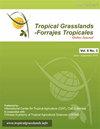播量、施肥时间和肥料类型对小麦产量、营养价值和青贮品质的影响
IF 0.7
4区 农林科学
Q3 AGRICULTURE, DAIRY & ANIMAL SCIENCE
引用次数: 0
摘要
全小麦是一种营养丰富的饲料作物,被广泛应用。本试验分为2个试验:试验1研究3种播量(320 kg/ha, S320;385公斤/公顷,S385;450kg / hm2, S450)和不同施肥时间,即苗期60%,拔节抽穗期40%;试验2考察了不同施肥类型(尿素、N:P:K复合肥和尿素+复合肥均为等氮)对青贮玉米产量、营养价值和青贮品质的影响。随着播种量的增加,干物质(DM)和粗蛋白质(CP)产量有增加的趋势,但相对饲料价值有降低的趋势。试验1:施二肥时间与播种率对小麦CP、粗纤维、粗灰分、粗灰分、无氮浸出物、中性洗涤纤维(NDF)、酸性洗涤纤维(ADF)浓度无显著交互作用(P>0.05)。而施肥时间与播种量对青贮发酵品质(pH、乳酸、丁酸和NH3-N浓度)影响显著(P0.05)。肥料类型对青贮pH、WCW青贮有机酸(丙酸除外)和NH3-N浓度有显著影响(P<0.05)。在本试验条件下,综合考虑DM产量、营养成分和青贮发酵品质,小麦作为饲料的最佳播量为385 kg/ha左右。氮肥应在苗期和拔节期施用。与单独施用尿素相比,尿素与复合肥混合施用对青贮饲料的产量和营养价值影响不显著,但能提高青贮饲料的发酵品质。不同土壤的结果可能不同。本文章由计算机程序翻译,如有差异,请以英文原文为准。
Effects of seeding rate, fertilizing time and fertilizer type on yield, nutritive value and silage quality of whole-crop wheat
Whole-crop wheat (WCW) is rich in nutrients and is widely used as a forage crop. This study consisted of 2 experiments: Experiment 1 studied the yield, nutritive value and silage quality of WCW at 3 seeding rates (320 kg/ha, S320; 385 kg/ha, S385; and 450 kg/ha, S450) and different fertilizing times, i.e. 60% at seedling stage and the remaining 40% at the jointing stage vs. heading stage; and Experiment 2 examined the yield, nutritive value and silage quality of WCW receiving different fertilizer types, i.e. urea, compound fertilizer (N:P:K) and urea + compound fertilizer (all iso-nitrogenous). With the increased seeding rate, dry matter (DM) and crude protein (CP) yields tended to increase, but relative feed value tended to decrease. Experiment 1: there was no significant interaction between time of applying the second fertilizer dose and seeding rate in terms of concentrations of CP, crude fiber, ether extract, crude ash, nitrogen-free extract, neutral detergent fiber (NDF) and acid detergent fiber (ADF) in wheat (P>0.05). However, a significant interaction between fertilizing time and seeding rate was observed in terms of silage fermentation quality (pH, lactic acid, butyric acid and NH3-N concentrations) (P<0.05). Experiment 2: DM yield, CP yield and concentrations of CP, ADF and water-soluble carbohydrate were not affected by fertilizer type (P>0.05). Fertilizer type had significant effects on pH of silage and concentrations of organic acids (except propionic acid) and NH3-N in WCW silage (P<0.05). Under the present study conditions, considering DM yield, nutrient composition and silage fermentation quality, an optimal seeding rate of wheat for forage appears to be about 385 kg/ha. N fertilizer should be applied at the seedling stage and jointing stage. Although applying a mixture of urea and compound fertilizer had no significant effects on yield and nutritive value of WCW relative to applying urea alone, it did improve silage fermentation quality. Results may differ on different soils.
求助全文
通过发布文献求助,成功后即可免费获取论文全文。
去求助
来源期刊

Tropical Grasslands-Forrajes Tropicales
Agricultural and Biological Sciences-Agronomy and Crop Science
CiteScore
1.60
自引率
0.00%
发文量
36
审稿时长
16 weeks
期刊介绍:
The Journal publishes, in English or Spanish, Research Papers and Short Communications on research and development, as well as contributions from practitioners (Farmer Contributions) and Review Articles, related to pastures and forages in the tropics and subtropics. There is no regional focus; the information published should be of interest to a wide readership, encomprising researchers, academics, students, technicians, development workers and farmers.
In general, the focus of the Journal is more on sown (''improved'') pastures and forages than on rangeland-specific aspects of natural grasslands, but exceptions are possible (e.g. when a submission is relevant for a particularly broad readership in the pasture and forage science community).
The Journal will also consider the occasional publication of associated, but closely related, research in the form of an additional scientific communication platform [e.g. a re-make of the former Genetic Resources Communication series of the former Division of Tropical Crops and Pastures of the Commonwealth Scientific and Industrial Research Organisation (CSIRO), Australia].
Areas of particular interest to the Journal are:
Forage Genetic Resources and Livestock Production[...]
Environmental Functions of Forages[...]
Socio-economic Aspects[...]
Topics within the aforementioned areas may include: Diversity evaluation; Agronomy; Establishment (including fertilization); Management and utilization; Animal production; Nutritive value; Biotic stresses (pests and diseases, weeds); Abiotic stresses (soil fertility, water, temperature); Genetics and breeding; Biogeography and germplasm collections; Seed production; Ecology; Physiology; Rhizobiology (including BNF, BNI, mycorrhizae); Forage conservation; Economics; Multilocational experimentation; Modelling.
 求助内容:
求助内容: 应助结果提醒方式:
应助结果提醒方式:


